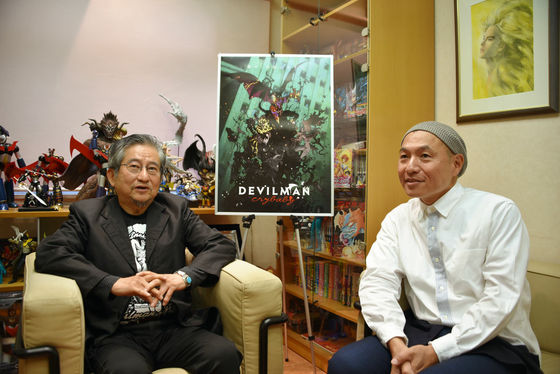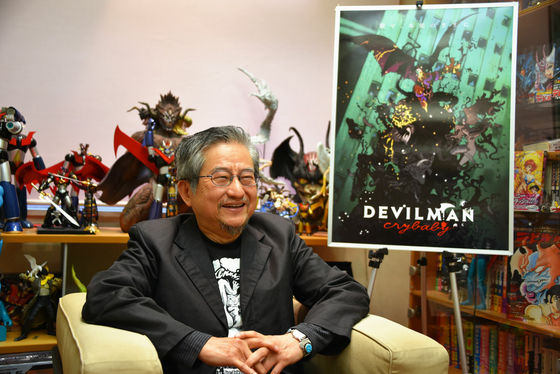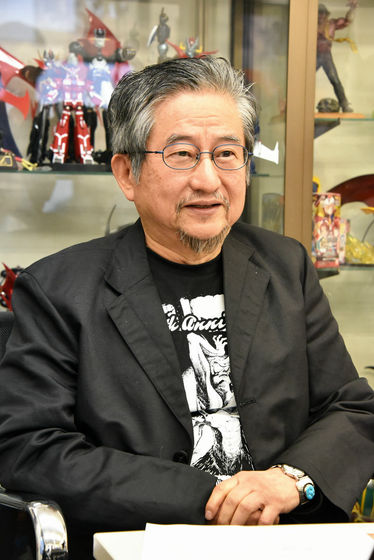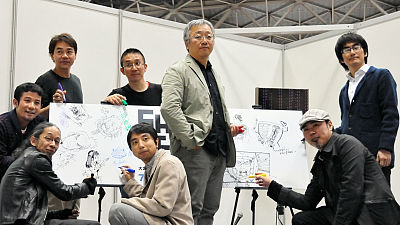Interview with Go Nagai and director Masaaki Yuasa about 'DEVILMAN crybaby' - they say it 'captures the essence of Devilman'

The Netflix original anime series 'DEVILMAN crybaby' began streaming on Friday, January 5, 2018. This work commemorates the 50th anniversary of Go Nagai's career as an artist, and it has been said that it would be impossible to completely adapt the manga due to its plot, and no work has actually been adapted up to the final scene until now. The person who took on this difficult challenge was director Masaaki Yuasa
DEVILMAN crybaby | Official website
http://devilman-crybaby.com/
Q:
Director Yuasa has previously said in interviews and events that he would rather create Devilman himself than have someone else do it. Why did he feel that he had to draw the ending of the Devilman manga version now? Also, I think he said that he wanted to draw 'something that lies deep within the work,' but what was that?
Masaaki Yuasa (hereinafter, Yuasa):
That's right. I really love 'Devilman,' but ultimately I felt it was scary. It seemed difficult to make, and I wondered if I could do it well. But if no one else did it, that would be fine, but I thought that if someone else did it, I would like to do it. Also, there hadn't been a film adaptation that said, 'This is how you do it,' so I didn't have any concrete ideas at the time (laughs), but I took on the challenge with the feeling that I would be able to show it.
'What Lies Deep Within' is something I said I 'liked' and 'was shocked' by the original work, but I probably didn't understand the final scene with Satan. I think I was talking about the feeling of wondering 'what is that?' At the end, Satan's feelings are depicted as 'I didn't want to lose Akira Fudo,' and I thought it would be good to portray that this time.
Q:
At the seminar stage of 'AnimeJapan 2017', Nagai said, 'I realized in the latter half of the story that 'the main character was Ryo'. So I brought him back to life after he had died. I didn't even discuss this with Yuasa-san.' What did you two talk about when you first met?
Go Nagai (hereinafter, Nagai):
I thought that I had already created what I wanted to express when I drew the work, so I said, 'How I handle it is up to me' (laughs). Devilman has been made into various anime in the past... there have been a lot of different things (laughs).
(Everyone laughs)
Nagai:
I think that once I provide the ingredients, that's it, and I don't care how they're cooked, so I told them, 'I'll leave it up to you.' Anyway, I said, 'Do whatever you want' (laughs). If there's something you want to change, you can change it, and no matter how it changes, I'll be happy.
Q:
Director Yuasa, what was the meeting like?
Yuasa:
It's just this generous feeling.
(Everyone laughs)
Yuasa:
There were a lot of things I wanted to ask and didn't understand, but when I heard that, I felt it was presumptuous to even ask (laughs). The work is already complete, so I guess that means we've parted ways (laughs).
Q:
'Farewell' (laughs)
Yuasa:
Mr. Nagai has drawn many works after 'Devilman', so I looked at his other works. From his autobiographical work 'Gekiman!', I was able to explore various things, such as 'Oh, so that's what this scene was about,' 'I thought that's what he was thinking,' and 'Did he want to draw a fuck scene between Devilman and Sirene?' (laughs)
(Everyone laughs)
Yuasa:
I think there are some interesting parts in 'Gekiman!' that were added later, but it also depicts things that were thought at the time, so I imagined things like, 'Maybe they wanted to do more back then. So, maybe we should do more in the anime.' as I was making it.

Q:
When I saw the preview, I felt that while it retained the taste of Nagai's drawings, Yuasa's artistry was also very apparent. As for Yuasa, what parts did you want to keep and what parts did you want to change when creating Devilman now?
Yuasa:
Basically, I wanted to convey the feeling I had when I read it as a high school student. When I read it, Devilman hadn't been out for that long, so it didn't feel strange to me that it was set in the 1970s, but I thought it would be a bit strange to preface it by saying, 'This is a story from the 1970s' when I was making it now. At the time, it was written as a story that could happen now, so I thought it would be better to set it in the present day, so I changed it. I also drew the parts that shocked me and that I found interesting as they were, but I made changes to the parts that I didn't understand and that I understood as I read it, so that I could easily understand them. Anime basically doesn't go back and forth, but progresses in one direction, so I thought, 'If I do it like this, will it be easy for me to understand at the time?'
Q:
Basically, you're keeping the original while making some adjustments.
Yuasa:
For example, there is a scene where a group of delinquents appears, and I thought, 'There aren't any delinquent groups these days that would start a fight like this.'
(Everyone laughs)
Yuasa:
I thought that today's bad guys are hiding quietly in the back and don't come out on their own. So I thought about what kind of people would be able to speak out on their own instead of this gang of delinquents, and I thought that rappers who look like they're bad would be the ones who would speak out their opinions. They're not just bad-looking, they expose their true feelings, so if you meet someone like Miki-chan who you think 'this guy knows what he's doing,' it's a reason to follow them, and it's not strange to end up together with them. In that case, I thought it would be good for a rapper to come along. They explain things like 'this is the kind of era we live in now' (laughs), and they also play the role of a bard, so I replaced it with 'if I were to do it now, I think it would be better to do it in this way.'
Q:
What specifically did you understand when you first read it, but did you understand as you continued reading?
Yuasa:
For example, there is a scene where Sirene, Kaim, and Ryo say 'There is no such thing as love.' They say that with their mouths, but in reality love does exist, and Ryo himself clearly realizes that affection later on. I made that scene with the intention of making it clear to me, even if I had just seen it at the time.
Q:
Please tell us your impressions of 'DEVILMAN crybaby' and any scenes that you thought were good. Also, since this work is a new form of content distributed via the Internet called Netflix, I would like to ask Mr. Nagai and Director Yuasa about their impressions of Netflix.
Nagai:
First of all, it was interesting. I had also seen 'Lu over the Wall' and 'The Night is Short, Walk on Girl,' and I thought, 'This director can make something quite surreal.' A story about diving into a demonic world that doesn't exist can look fake if it's made too realistic, so I thought it would be good to go ahead and make it with a forcefully abstract image like this, and make people realize that Devilman itself is an abstract depiction of something familiar.
When I was drawing Devilman, I felt that the devil was the form of the development of human weapons. To be 'demonized' is the same as being suddenly taken to the battlefield, being handed a deadly weapon, and being told, 'You can kill as much as you want.' I think the devil represents the fact that everyone is drafted into the military or caught up in terrorism and is sent to fight. God's army also appears as a 'ball of light,' but that depicts hydrogen bombs and nuclear attacks as a group of angels. I thought that the animation style of Director Yuasa might be the best way to make people realize that it was an abstract thing.
Q:
One of the features of Netflix is that there are few restrictions on expression and it allows for a free setting for stories to be told.
Nagai:
That's the best thing. There are a lot of sex scenes in it (laughs). This is something that hasn't been possible before. People who think 'I shouldn't see it' don't have to watch it, and people who want to watch it can watch it, so there's a lot of freedom. I think it would have been a work that couldn't have been made with so many restrictions.
Q:
Mr. Yuasa, what are your thoughts on participating in this type of production?
Yuasa:
There were some things that were possible because of the high degree of freedom, and because there was no clear rule about the length itself, I was able to adjust the ending for each episode in various ways, and it was also good that I could be flexible. If you tell a story like this, you can't avoid the Internet. It's something that's never happened before, that such a story can be provided in an environment where people all over the world can see it if they want to. I've never been seen by so many people, so I think it's great to be able to do a big title like 'Devilman' and have people all over the world watch it through streaming (laughs).
Nagai:
Devilman was made 45 years ago, when there was no internet or smartphones, and it was impossible to imagine the modern era. Now, however, we live in an internet society, and even just online there are criticisms and flame wars. There is a possibility that a dangerous world awaits us. Director Yuasa has depicted these aspects well, and I think he has made it clear that the direction he wanted to take with 'Devilman' is still relevant in the modern age.
Q:
One of the features of this work is that it depicts the story of 'Devilman' in detail until the very end. Another thing is that the character setting of the 'Athletics Club' and the expression of 'passing the baton' appear, which I felt were 'secret ingredients' that Director Yuasa put in with great care...
Yuasa:
I wanted to express 'differences in strength' in an easy-to-understand way using an image of people running on track and field. Fast people are strong, and slow people are weak. Humans are slower runners than dogs and cats, but for some reason they run as hard as they can. I gave meaning to ambition that seems meaningless at first glance as ideals and love in the face of reality. And Miki-chan is a girl with ideals, and she doesn't want to give up on her ideals no matter what the situation, so I used track and field to depict that.
When I thought about what kind of story 'Devilman' is, I thought it was a story about conveying love to Asuka and Ryo. Why does Miki love Akira, why does Akira love Miki, why does Ryo love Akira? So I used the form of a baton relay to express that 'Akira and the others have already realized what Ryo will realize in the end. In order to make Ryo understand this, Akira and the others try to convey it to Ryo without abandoning it, even though they are pushed by various realities.'
Even if I'm no good, it will spread to other people, and they will continue on... I think it's the same with the spread of the Internet, if you're alone you don't have much power, but if it spreads, it becomes powerful. It may be a naive idea like John Lennon's 'Imagine', but the possibility is not zero. Even when making a realistic decision, I think it's good to judge the situation with an ideal rather than just judging the situation, so I think of it as a bit of an idealistic idea of handing over the feeling of 'Akira's love to Ryo' to a baton.

Q:
A question for Mr. Nagai. In an interview about 'Cyborg 009 VS Devilman,' he said, 'I heard later that in the manga, Sirene and Devilman were going to have sex.' To which he replied, 'Oh, that was just something I thought in my head (laughs). It would be really difficult to do something like that in real life (laughs). Even the editorial department knew it was impossible, so I didn't think I'd go that far, but in my head I was like, 'I'd like to try that,' 'I'd like to draw that,'' (laughs). This time, Director Yuasa was in that spirit (laughs), and there was a scene full of intense eroticism. What are your impressions after watching it?
Nagai:
First of all, I thought, 'Oh no, I did it!' (laughs)
(Everyone laughs)
Q:
'Oh, you finally did it'? (Laughs)
Nagai:
Like, 'That's nice' (laughs)
Q:
'That's nice!' (laughs) Director Yuasa, how did you feel about that scene, or rather, the many sexual depictions in the film?
Yuasa:
After all, it was Professor Nagai who asked me to do it.
(Everyone laughs)
Q:
It wasn't a direct request, was it?
Nagai:
I didn't make a request lol
Yuasa:
It's just a fantasy. I don't want to depict it so directly, and I think that's about the limit.
(Everyone laughs)
Q:
I think 'Miki's Death' is a very symbolic scene, but when I was reading a commentary book by Mr. Nagai about 20 years ago, I saw him write that he was in a trance state and was surprised when he read later that she had died. What were your thoughts when you wrote that scene at the time?
Nagai:
It was too late to turn back halfway. If Devilman had saved Miki and not let her die, the story would have become a normal manga. I thought that would mean the author himself was denying the development of the story up to that point. The truth is that the situation was such that 'I don't want her to die, but I have no choice but to let her die.'
Q:
It was a very symbolic scene, and I think it was an important part of the DEVILMAN crybaby series. That's why it had to be an episode with only one key animation.
Yuasa:
This time, I did episodes 4 and 9 by myself. Episode 5 was also done by him quite a bit. It was the scene that shocked me the most, so I wanted to do it myself, but I drew only the storyboard and had him do it. When you leave it to one person to draw the animation, they can add something even more. I am also the director, but I thought he went above and beyond, so I called it a 'divine episode' (laughs).
(Everyone laughs)
Yuasa:
That was the point that shocked me the most when I first read 'Devilman', and although I said I would depict it to the end in 'DEVILMAN crybaby', I thought I couldn't go to the end without depicting Miki's death. So I was working on it hoping I could depict it properly, but when they actually did it, I was glad that they came up with something that I thought 'could be able to depict it'. Miki's screams were also full of spirit, and it was painful to watch them over and over during dubbing (laughs).
(Everyone laughs)
Q:
Like the scene where Miki is killed, the battle scenes and sexual scenes drawn by Yuasa are not so violent as to be called 'grotesque,' and there are even some parts that remind me of a little cuteness, including the designs of the demons. Earlier, Nagai-san said that it was 'abstract,' but was that something you were conscious of?
Yuasa:
At first, I was thinking of doing it in a more linear and stylish way, but Kiyotaka Oshiyama of Devil Design also likes the original work, and I felt that he would draw it in a slightly rounded and cute way. If you draw it in a linear and stylish way, it feels a bit crisp and lacking in texture. It's not just cute, but also a bit goofy and sensual. The touch of the eerie original work is also curvaceous, so I thought it would be an affinity, so I asked him to do it as it is.
Q:
In an interview on the official website, Director Yuasa said, 'I thought, 'I'd rather make it myself than have someone else do it.' (Omitted) That's why I'm currently having a lot of trouble with the production.' What was the most difficult part of making 'DEVILMAN crybaby'?
Yuasa:
When the final situation spreads around the world, I wondered if I could portray it spectacularly, and how I could do it. In terms of the amount of material, I probably wouldn't be able to draw it all if I did it properly, so I was worried that I wouldn't know until I tried it, 'Can I draw only a part of it and create an atmosphere that it's happening all over the world?' But when I finished, I think I was able to draw it somehow. There may have been a better way to do it, but I feel like I did my best and was able to do it.
Nagai:
Anyway, even the smallest details, from the supporting characters to everything else, were tweaked and changed, but the essential parts of 'Devilman' were all properly captured, so it really was a proper 'Devilman' (laughs).

Yuasa:
Thank you. I got a good one.
(Everyone laughs)
Q:
You are both active creators, but there are deadlines involved in drawing manga and making anime. Do you have any techniques or mentality to meet deadlines?
Nagai:
All I can do is 'keep going no matter how hard it is until I get there' - that's it (laughs).
Q:
(lol)
Nagai:
Ken Ishikawa, who has passed away, once said, 'This job is really good, but it would be so much better if there were no deadlines. How much fun it would be.' (laughs) I also said, 'That's true,' but added, 'But if there were no deadline, the manuscript might not be completed.' (laughs)
(Everyone laughs)
Nagai:
I end up wanting to work on it more and more. I have to let it go at some point, and I can let it go because I have a deadline. Even with my drawings, I could have done better if I spent more time on them, but the ones I finish are always like, 'Oh, I should have drawn it a little better,' or 'I didn't have enough time,' and I always thought that.

Q:
What about Director Yuasa? You released two movies in 2017, and in January 2018, DEVILMAN crybaby will begin streaming, so you've been releasing works at a rapid pace.
Yuasa:
Yes, if I had the time I'd like to keep doing it.
Q:
I want to keep doing this forever! (laughs)
Yuasa:
I guess I do it because there is a deadline. If I meet the deadline, it makes it easier for the next person to do their job, and if we finish on time, we don't have to spend extra money.
Q:
(lol)
Yuasa:
In the end, I think that will be a way that everyone will be happy with. Even if I don't reach my ideal, I think, 'I wanted to go as far as this,' and I try to use that experience again when I do my next work. I also have a stance of 'meeting deadlines' (laughs).
Q:
(laughs) Thank you very much.
'DEVILMAN crybaby' consists of 10 episodes and is available exclusively worldwide on Netflix.
Nagai Go 50th Anniversary Work 'DEVILMAN crybaby' Nagai Go Edition 29 seconds - YouTube
Related Posts:







